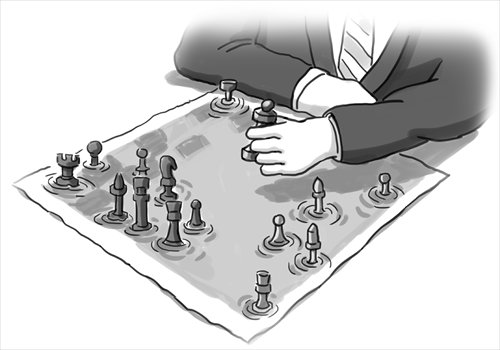

 |
| (Illustration: Liu Rui/GT) |
Relations between China and some ASEAN countries have been in the spotlight in recent years. For ASEAN, China is a close neighbor that they must learn how to get along with; for China, ASEAN is a strong link that cannot be replaced in its "One Belt, One Road" initiative.
As sovereignty disputes concern core interests and they cannot be addressed in the short term, the most practical way to deal with these issues would be to impose some calculated rules on the game. In this regard, all parties should agree to resolve the disputes through diplomatic, economic and legal channels instead of the use of force, and put the problem-solving process in a controllable range.
Currently, China has been criticized for unilaterally changing the status quo in the South China Sea by expanding construction on some disputed islands. However, these criticisms ignore the fact that some other claimants especially the Philippines and Vietnam have been exploring their occupied islands for years and China has shown forbearance.
In this case, what really matters is how these claimants can find an effective interactive mechanism to avoid relentless antagonism based on misunderstandings and miscalculations.
Many observers have ignored how China is trying to strike a balance between safeguarding of interests and maintenance of regional stability. China has been endeavoring to sign a good-neighbor treaty of friendship with ASEAN, but has got few positive responses. ASEAN needs to take a proactive step to explore an agreeable interactive mechanism with China.
However, the Philippines and Vietnam, the two important South China Sea claimants within ASEAN, are thinking of something else. Since 2014, both countries have been engaged in a joint effort to establish a strategic partnership. A blueprint has been produced in less than a year, and the potential influence of the partnership merits close attention.
Mutual concerns over the South China Sea are probably the biggest factor that pushes both sides close. It seems to be natural that Manila and Hanoi seek cooperation to counter China. But a targeted and adversarial approach will only complicate and even paralyze the disputes.
As for most ASEAN claimants, they have several options in dealing with the disputes with China. The first option is a one-on-one interactive system between China and each other claimant. The second option is cooperation between all claimants save for China. The Manila-Hanoi partnership is one of the latest moves toward this. The third option is making ASEAN a platform where all claimants can discuss these matters fair and square. The fourth one is introducing exterior forces such as the US and Japan to counterbalance China's influence.
The first option, proposed by China, is the last choice Manila and Hanoi want. The two should not count on the fourth one, as the US is unlikely to sacrifice its own interests to aid ASEAN countries.
A Manila-Hanoi strategic partnership is unlikely to work, either. First, there are also territorial and sovereignty issues between them. As socialist countries, Vietnam and China's common interests in ideology are no less significant than their disputed territorial interests. And Manila and Hanoi's combined strength is merely a fraction of China's. Thus, their partnership is more of a token than making a real difference. In the short run, this partnership might gain themselves some leverage in dealing with China, but these petty interests would be acquired at the larger cost of China's trust, thus doing no good to peace in the South China Sea.
Therefore, the third option, which includes ASEAN in mediation, is the point where the interests of all parties can be balanced. Chinese Foreign Minister Wang Yi has suggested a dual-track approach, which seeks a one-on-one mechanism in sovereignty issues, but an all-inclusive system in regional peacekeeping. China has offered a flexible solution, and now is time that the other claimants show their sincerity.
 Attendants-to-be join Mr. & Miss Campus Contest
Attendants-to-be join Mr. & Miss Campus Contest China hosts overseas disaster relief exercise for the first time
China hosts overseas disaster relief exercise for the first time 20 pairs of twins who will become flight attendants in Sichuan
20 pairs of twins who will become flight attendants in Sichuan J-11 fighters in air exercise
J-11 fighters in air exercise PLA soldiers operating vehicle-mounted guns in drill
PLA soldiers operating vehicle-mounted guns in drill Beauties dancing on the rings
Beauties dancing on the rings Blind carpenter in E China's Jiangxi
Blind carpenter in E China's Jiangxi Top 10 highest-paid sports teams in the world
Top 10 highest-paid sports teams in the world In photos: China's WZ-10 armed helicopters
In photos: China's WZ-10 armed helicopters Obama is sowing discontent in S.China Sea
Obama is sowing discontent in S.China Sea Rescuers work through night to reach cruise ship survivors
Rescuers work through night to reach cruise ship survivors Driving through limbo
Driving through limbo Facing down MERS
Facing down MERSDay|Week